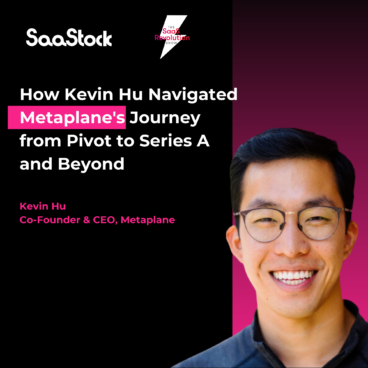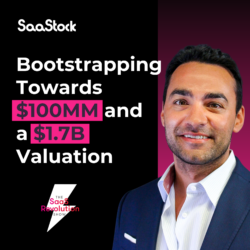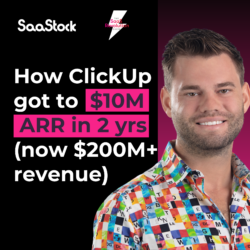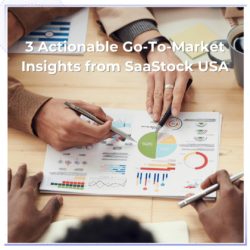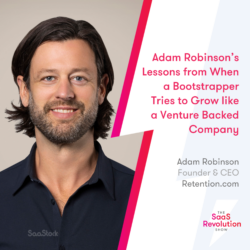In this episode of the SaaS Revolution Show our host Alex Theuma is joined by Kevin Hu, Co-Founder & CEO at Metaplane.
“When it comes to the CEO job, one can hope that the problems never stop. When the problems stop, I think that’s when growth stops. The best case scenario is when the problems are new problems all the time and it doesn’t feel like Groundhog Day.”
Kevin shares:
- The reasons that drove Metaplane to pivot (twice).
- The importance of attracting strong leaders and building a repeatable sales process as a company grows.
- His approach to decision-making and prioritisation; from the way he collects information to committing to decisions.
- Why being upfront about expectations and offering upside potential is crucial to recruiting top talent.
- Metaplane’s unique onboarding process where new hires “ship something” on day one.
- Overcoming market headwinds through a product-led approach and land-and-expand strategy.
Watch (or listen) to the full episode below or read on for key takeaways.
The Metaplane Story
Two pivots, $22M raised, and an acquisition by Datadog. All in just six years.
In some respects, Metaplane’s journey is the epitome of SaaS success: spot a problem, create a great solution, pivot towards a greater opportunity, and get the just reward.
But to successfully navigate your SaaS solution from a general data analysis tool to a SaaS-focused data catalogue to a data observability platform requires something special.
On the podcast, Metaplane Co-founder and CEO Kevin Hu discussed the key decisions that fuelled Metaplane’s flight and the essential learnings from the journey.
Y Combinator
“It’s very common to lose sight of the most important thing, which is your main metric and making that number go up.”
Founded in 2019, Metaplane joined the ‘Covid batch’ of Y Combinator in the winter of 2020, which instilled three core values early on.
- Avoid common failures: Be it running out of money or having friction with your co-founders, be aware of (and prepare to avoid) the common pitfalls.
- Keep your focus: There’s so many distractions – from growing the team to vanity metrics – but never lose sight of your main growth metric. Ask yourself: is it going up? If not, why not? If yes, what are you going to do to get your next 100 customers?
- Pivot towards opportunity: YC arranged founders to speak to us, many of whom pivoted their companies. This gave us the mindset and conviction to make that pivot post YC.
Early pivot
“Metaplane is now a data engineer in a box just staring at your tables all day.”
But it didn’t start out that way. According to Kevin, Metaplane “started with more general automated data analysis tools, working on that through Y Combinator and a pre-seed round to a more specific data analysis tool focused on SaaS companies to a data catalogue and then finally to what we’re working on today, which is data observability.”
How did they pivot successfully?
- Gather intel: Collect as much information as possible by running light experiments and being intellectually honest with the results. Then make the call and commit.
- Commit and execute: After making the call, success boils down to committed execution. Get all your team focused on delivering it.
- Embrace problems: Problems stop when growth stops. The best case scenario is when the problems are new problems all the time.
Getting to Series A
“Feedback is sometimes just as important as revenue.”
In March 2024, Metaplane closed a $13.8M Series A. Reflecting on what helped them, Kevin highlighted their:
- Product focus: Building a product that speaks for itself, in terms of capabilities and reputation in the space, helped the whole sales cycle. In addition, committing to a product-led growth approach helped them avoid the economic headwinds more than top-down sales-led growth companies.
- Direct customer feedback. In the early days when you’re still trying to figure out your direction, forgoing a bit of revenue in order to build a better product has a huge downstream impact.
- Land and expand approach. Not all revenue is created equal. Getting a $10K contract from a customer that lives in the future that’s really aligned with your vision could be worth $100K later on.
On the path to Series B
“Hire slow, fire fast. High salary, high equity, high expectations.”
For Kevin, going from $1-10M ARR requires a combination of:
- A repeatable go-to-market process.
- Hitting the classic series B metrics (i.e. ARR, NRR, customer base, and sales cycle).
- Strong leaders that can build out the team and Series B investors can make a bet on.
When it comes to hiring, Kevin optimises the probability of success by being extremely upfront about what’s expected. In addition, he:
- Hires leaders that force outcomes: The leaders that state their goal (and why) and then go to the ends of the Earth to make it happen.
- Emphasises the upside potential: The best leaders want to exert influence on the organisation, so instead of saying ‘take this off my plate and hit this NRR number,’ highlight their capacity to shape the programme.
- Sets the tone with onboarding: At Metaplane, everyone ships something on Day One. If you’re an engineer you submit a PR, if you’re a marketer you write a blog, if you’re a salesperson you review some Gong calls and write a summary.
Acquisition by Datadog
Well, Metaplane didn’t need to get to Series B. In April 2025, Datadog purchased the company with its VP Michael Whetten saying the deal accelerates Datadog’s data observability offer and will help organisations build complex and reliable AI systems.
As part of the deal, Metaplane will continue as a standalone product (‘Metaplane by Datadog’) and support its existing/new customers.
But what does the acquisition mean for Kevin as CEO-Founder?
On LinkedIn, Kevin reflected on his first 90 days at Datadog, stating:
- He didn’t just join a company, but a seasoned data observability team.
- Working at a much larger company is different, especially in terms of coordination.
- The core day-to-day is similar: talk with customers, build product, repeat (but without having to deal with fundraising, payroll, and accounts payable etc.)
If you’re thinking about pivoting or debating a potential acquisition, speak to CEO-Founders that have been there, done that. Check out SaaStock’s founder membership and our upcoming community events.
